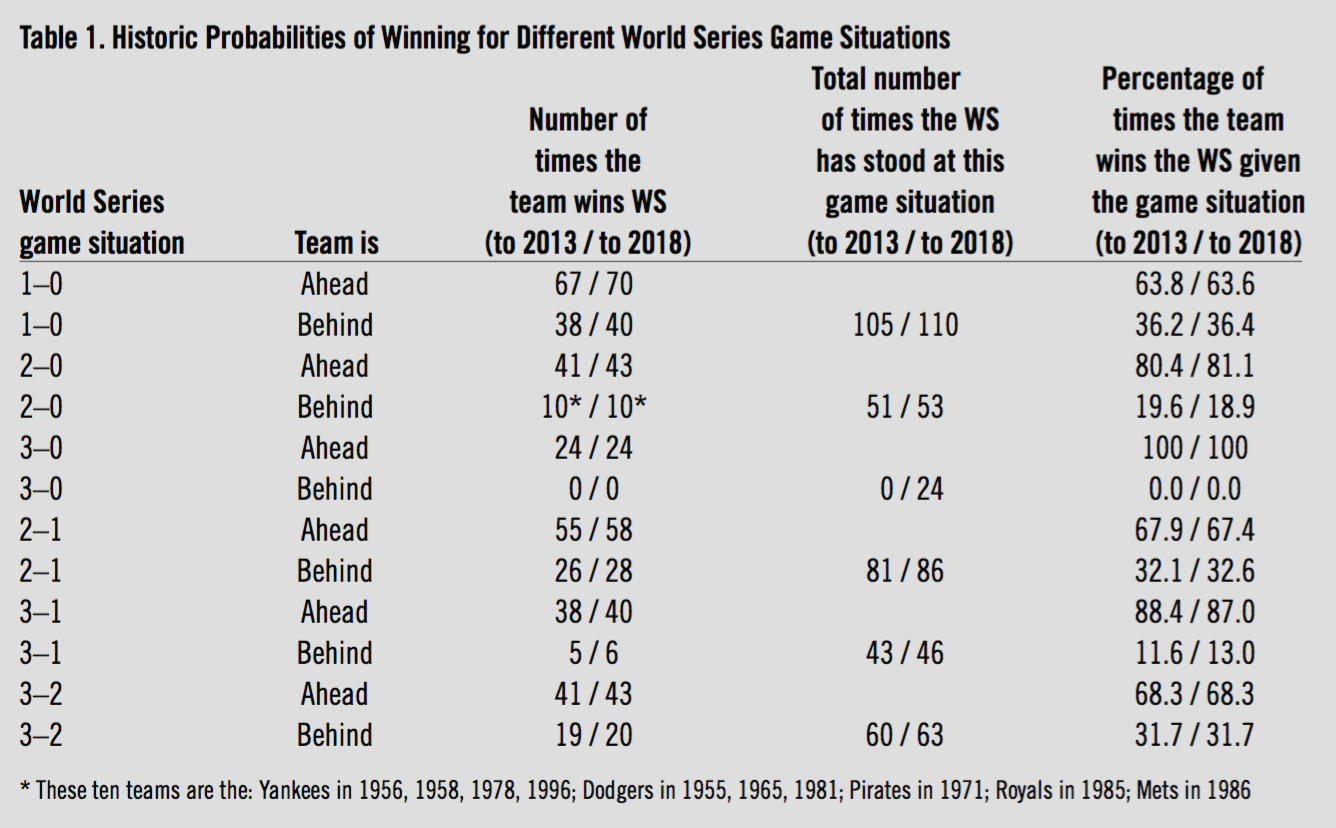World Series Game Situation Winning Probabilities: An Update
This article was written by Douglas Jordan
This article was published in Spring 2019 Baseball Research Journal
This is a brief update to the article, “World Series Game Situation Winning Probabilities: How Often Do Teams Come Back From Behind?” that appeared in the Fall 2014 Baseball Research Journal. The original paper calculated the probabilities of winning the World Series for all possible game combinations; the update includes data for the five World Series played in 2014–18. Table 1 contains both the original results through the 2013 season, and additional analysis which includes the results for the next five seasons.
Table 1: Historic Probabilities of Winning for Different World Series Game Situations
(Click image to enlarge.)
To summarize the data in the table succinctly: a team that leads the World Series by one game (1-0, 2-1, or 3-2) wins the series approximately two-thirds of the time. A team that leads by two games (2-0 or 3-1) wins the Series roughly 80 percent of the time. This means that it is vitally important for the team that lost Game 1 to win Game 2. History shows that it is very difficult to come back from an 2-0 deficit. The same reasoning applies to Game 4. Game 4 is almost a must-win game for the team that is behind 2-1 in order to avoid falling into a 3-1 hole. Only six teams (see the earlier paper for the list) have ever won the World Series after being down 3-1.
World Series results from 2014–18 illustrate these two ideas. The Mets (2015) and Dodgers (2018) lost the first game of the Series and then failed to win Game 2. Both lost in five games. The Giants (2014) and Dodgers (2017) won Game 4 to tie the Series at two games each. Each of those World Series went the full seven games which gave both of those teams a good chance to win. The Giants did prevail in 2014 while the Dodgers lost to the Astros in 2017.
What impact have the World Series results from 2014–18 had on the data presented in the 2014 article? The biggest change is that the chance of winning for a team that is behind 3–1 increased from 11.6 percent to 13.0 percent. This 12 percent (1.4/11.6) increase in the percent chance of winning is a result of the Cubs coming from behind 3–1 to win the World Series in 2016. The Cubs were only the sixth team in history (out of 46) to come back from that deficit to win. But it was a close call for the Cubs. They won Games 5 and 7 by one run and Game 7 went 10 innings. The other fairly large change is in the 2–0, 0–2 situation. Both the Royals and Red Sox (in 2015 and 2018 respectively) won the first two games and then went on to win the championship. This increases the percentage of teams that have won when being ahead 2–0 from 80.4 percent to 81.1 percent and decreases the percentage of winning for teams that are behind 0–2 from 19.6 percent to 18.9 percent.
DOUGLAS JORDAN is a professor at Sonoma State University in Northern California where he teaches corporate finance and investments. He has been a SABR member since 2012. He runs marathons when he’s not watching or writing about baseball. Email him at douglas.jordan@sonoma.edu.



